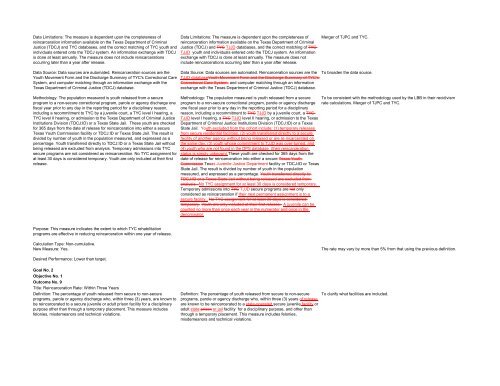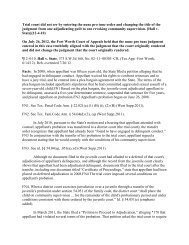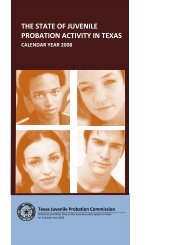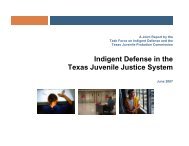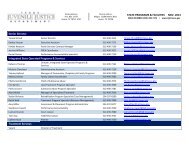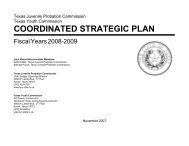(TJJD) Office of Inspector General - Texas Juvenile Justice Department
(TJJD) Office of Inspector General - Texas Juvenile Justice Department
(TJJD) Office of Inspector General - Texas Juvenile Justice Department
You also want an ePaper? Increase the reach of your titles
YUMPU automatically turns print PDFs into web optimized ePapers that Google loves.
Data Limitations: The measure is dependent upon the completeness <strong>of</strong>reincarceration information available on the <strong>Texas</strong> <strong>Department</strong> <strong>of</strong> Criminal<strong>Justice</strong> (TDCJ) and TYC databases, and the correct matching <strong>of</strong> TYC youth andindividuals entered onto the TDCJ system. An information exchange with TDCJis done at least annually. The measure does not include reincarcerationsoccurring later than a year after release.Data Limitations: The measure is dependent upon the completeness <strong>of</strong>reincarceration information available on the <strong>Texas</strong> <strong>Department</strong> <strong>of</strong> Criminal<strong>Justice</strong> (TDCJ) and TYC <strong>TJJD</strong> databases, and the correct matching <strong>of</strong> TYC<strong>TJJD</strong> youth and individuals entered onto the TDCJ system. An informationexchange with TDCJ is done at least annually. The measure does notinclude reincarcerations occurring later than a year after release.Merger <strong>of</strong> TJPC and TYC.Data Source: Data sources are automated. Reincarceration sources are theYouth Movement Form and the Discharge Summary <strong>of</strong> TYC's Correctional CareSystem, and computer matching through an information exchange with the<strong>Texas</strong> <strong>Department</strong> <strong>of</strong> Criminal <strong>Justice</strong> (TDCJ) database.Methodology: The population measured is youth released from a secureprogram to a non-secure correctional program, parole or agency discharge onefiscal year prior to any day in the reporting period for a disciplinary reason,including a recommitment to TYC by a juvenile court, a TYC level I hearing, aTYC level II hearing, or admission to the <strong>Texas</strong> <strong>Department</strong> <strong>of</strong> Criminal <strong>Justice</strong>Institutions Division (TDCJ:ID) or a <strong>Texas</strong> State Jail. These youth are checkedfor 365 days from the date <strong>of</strong> release for reincarceration into either a secure<strong>Texas</strong> Youth Commission facility or TDCJ:ID or <strong>Texas</strong> State Jail. The result isdivided by number <strong>of</strong> youth in the population measured, and expressed as apercentage. Youth transferred directly to TDCJ:ID or a <strong>Texas</strong> State Jail withoutbeing released are excluded from analysis. Temporary admissions into TYCsecure programs are not considered as reincarceration. No TYC assignment forat least 30 days is considered temporary. Youth are only included at their firstrelease.Data Source: Data sources are automated. Reincarceration sources are the To broaden the data source.<strong>TJJD</strong> databaseYouth Movement Form and the Discharge Summary <strong>of</strong> TYC'sCorrectional Care System, and computer matching through an informationexchange with the <strong>Texas</strong> <strong>Department</strong> <strong>of</strong> Criminal <strong>Justice</strong> (TDCJ) database.Methodology: The population measured is youth released from a secure To be consistent with the methodology used by the LBB in their recidivismprogram to a non-secure correctional program, parole or agency discharge rate calculations. Merger <strong>of</strong> TJPC and TYC.one fiscal year prior to any day in the reporting period for a disciplinaryreason, including a recommitment to TYC <strong>TJJD</strong> by a juvenile court, a TYC<strong>TJJD</strong> level I hearing, a TYC <strong>TJJD</strong> level II hearing, or admission to the <strong>Texas</strong><strong>Department</strong> <strong>of</strong> Criminal <strong>Justice</strong> Institutions Division (TDCJ:ID) or a <strong>Texas</strong>State Jail. Youth excluded from the cohort include: (1) temporary releasesfrom secure residential facilities, (2) youth transferred directly to a securefacility <strong>of</strong> another agency without being released or are re-incarcerated onthe same day, (3) youth whose commitment to <strong>TJJD</strong> was over-turned, and(4) youth who are not found in the DPS database (their reincarcerationstatus is simply unknown).These youth are checked for 365 days from thedate <strong>of</strong> release for reincarceration into either a secure <strong>Texas</strong> YouthCommission <strong>Texas</strong> <strong>Juvenile</strong> <strong>Justice</strong> <strong>Department</strong> facility or TDCJ:ID or <strong>Texas</strong>State Jail. The result is divided by number <strong>of</strong> youth in the populationmeasured, and expressed as a percentage. Youth transferred directly toTDCJ:ID or a <strong>Texas</strong> State Jail without being released are excluded fromanalysis. No TYC assignment for at least 30 days is considered temporary.Temporary admissions into TYC <strong>TJJD</strong> secure programs are not onlyconsidered as reincarceration if their next permanent assignment is to asecure facility.. No TYC assignment for at least 30 days is consideredtemporary. Youth are only included at their first release. A juvenile can becounted no more than once each year in the numerator and once in thedenominator.Purpose: This measure indicates the extent to which TYC rehabilitationprograms are effective in reducing reincarceration within one year <strong>of</strong> release.Calculation Type: Non-cumulative.New Measure: Yes.The rate may vary by more than 5% from that using the previous definition.Desired Performance: Lower than target.Goal No. 2Objective No. 1Outcome No. 9Title: Reincarceration Rate: Within Three YearsDefinition: The percentage <strong>of</strong> youth released from secure to non-secureprograms, parole or agency discharge who, within three (3) years, are known tobe reincarcerated to a secure juvenile or adult prison facility for a disciplinarypurpose other than through a temporary placement. This measure includesfelonies, misdemeanors and technical violations.Definition: The percentage <strong>of</strong> youth released from secure to non-secure To clarify what facilities are included.programs, parole or agency discharge who, within three (3) years <strong>of</strong> release,are known to be reincarcerated to a state-operated secure juvenile facility oradult state prison or jail facility for a disciplinary purpose, and other thanthrough a temporary placement. This measure includes felonies,misdemeanors and technical violations.


